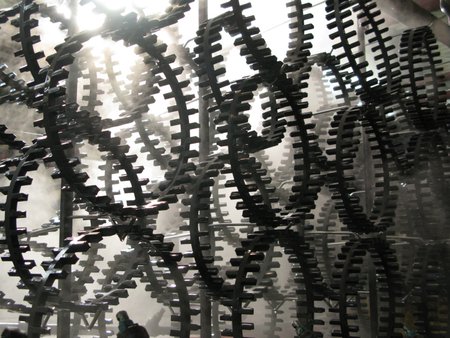Phosphating of steel
- Mangan phosphate
- Zinc – calcium - phosphate (thin layer phosphate)
Chemical reactions of metal surfaces caused by watery phosphate solutions result in the generation of a conversion layer that consists of highly adhesive metal phosphates occur during the phosphating process. Phosphate plated metals have numerous applications and are deployed in a variety of sectors. Thanks to its properties, phosphating plays a particularly important role in metal and materials technology. Because of its solid adhesion properties, it is frequently used to prepare for the actual coating or painting process. This finishing method is usually used in conjunction with steel.
Phosphating - process sequence
First, oxides and oils have to be removed from the metal surfaces prior to finishing. The work piece to be treated is stained in the first step. Metal oxides are moved into the solution under the emergence of hydrogen. In the main phosphating step, the metallic surface is immersed into phosphoric acid. The metal dissolves and forms salt corrosion products. An even crystal layer is created on the surface that protects the metal from further acid attacks and acts like an insulation. This rough phosphate crystal layer is the ideal adhesion base for the subsequent paint job or for the absorption of oils and lubricants.
Phosphating offers numerous advantages
As a finishing method, phosphating of steel delivers a lot of benefits. Besides providing temporary protection from corrosion, which is the result of phosphating on steel, its input and sliding qualities are also improved. Another positive aspect of phosphating is its impact on in particular the toothing components, since it reduces their fragility. The process, which is frequently used in conjunction with rubber-metal combinations, also delivers connector adhesion strength.
Functional improvements/properties of phosphating:
- Temporary corrosion protection
- Improvement of the input & sliding properties
- Reduction of the fragility of toothing components
- Reduction of friction during deformation
- Adhesion base for paint
- Rubber-metal connections
- Electrical insulation
Base material: steel
Retroactive treatment: As a phosphating add-on service, we offer our customers the retroactive treatment of the phosphate plated steel with the following materials:
Oil, water/Oil emulsion, Protektil.
Our equipment capacity for the phosphating of steel:
Rack bath 1:
L = 2700 mm D = 1200 mm W = 500 mm up to 1600kg unit weight
Rack bath 2:
L = 1300 mm D = 900 mm W = 500 mm up to 5000kg unit weight
Drum bath:
perforation from 2.5 mm
Technical basis:
Based on the latest fundamentals and provisions.
Metal finishing expert – the Rudolf Clauss GmbH & Co. KG
has in its repertoire. Numerous other processes, in particular in the discipline of galvanic applications – including galvanic silver plating, galvanic nickel plating or the galvanization of aluminum – are part of the metal finishing expert’s portfolio.
Today, the medium-sized, family-operated company domiciled in Mülheim an der Ruhr is under the management of the third Clauss generation. Thanks to the continuous further development of our system technology, we can respond quickly and flexibly to a vast array of demands and deliver consistent quality.
Please do not hesitate to reach out to our competent and cordial employees who make up the staff of the Rudolf Clauss GmbH & Co. KG, if you have any phosphating-related questions.

